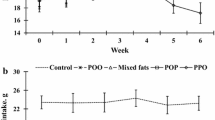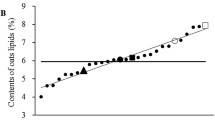Abstract
Low-fat cookies prepared by partial replacement of butter oil with different types of carbohydrate-based fat replacers were organoleptically evaluated. The best two types were selected to determine optimum fat replacement levels. The best four treatments as well as the control were evaluated in rats to ascertain their effects on serum lipids (total cholesterol, LDLcholesterol, HDL-cholesterol and triglycerides), fatty acid composition of rat liver and kidney lipids, food intake, body weight, weight gain and organ weights. High quality, low-fat cookies were produced by partial replacement of butter oil of the control with 250 or 500 g/kg of N-Oil or N-Flate plus Firm-Tex (1:1). Feeding rats low-fat cookie diets prepared with either N-Oil or N-Flate plus Firm-Tex (1:1) at 250 or 500 g/kg fat replacement levels resulted in a significant decrease in total serum cholesterol, low-density lipoprotein (LDL-cholesterol), high-density lipoprotein (HDL-cholesterol) and triglycerides (TG) compared to rats fed the control diet. Liver and kidney lipids in rats fed the low-fat cookie diets had lower percentages of palmitic, stearic, myristic and palmitoleic acids compared to the control. In contrast, percent compositions of oleic, linoleic and linolenic acids were greater in rats fed low-fat cookie diets. Food intake, body weight and weight gain were not influenced by diets formulated with fat replacers. On the other hand, liver, spleen, and testa weights in rats fed the low-fat cookie diets were significantly higher than those fed the control diet.
Similar content being viewed by others
References
AHA (1996) Dietary guidelines for healthy Americans. Circulation 94: 1795–1800.
USDA, USDHHA, (1995) Nutrition and Your Health: Dietary Guidelines for Americans. 4th ed. Home and Garden Bulletin, No 232, US Department of Agriculture and US Department of Health and Human Service, Washington, DC.
USDHHS (1988) The Surgeon General's Report on Nutrition and Health. Publ No 88– 50210 US Govt Print Office, Washington, DC.
Swanson BG, (1998) Fat replacers: Part of bigger picture. Food Technol 52: 16–19.
Cotton JR, Blundell J (1994) Dietary fat, food habits and appetite. Nutr Food Sci 6: 4–9.
McNamara DJ (1993) Dietary fatty acids, lipoproteins and cardiovascular disease. Adv Food Nutr Res 36: 253–259.
Grundy SM, Denke M (1990) Dietary influences on serum lipids and lipoproteins. J Lipid Res 31: 1149–1152.
Hayes KC, Pronczuk A, Lindsey S, Diersen-Schade D (1991) Dietary saturated fatty acids (12:0, 14:0, 16:0) differ in their impact on plasma cholesterol and lipoproteins in nonhuman primates. Am J Clin Nutr 53: 491–495.
Keys A, Anderson JT, Grande F (1965) Serum cholesterol response to changes in the diets. IV. Particular saturated fatty acids in the diet. Metabolism 14: 776–781.
Gresti J, Bugaut M, Maniongui C, Bezard J (1993) Composition of molecular species of triacylglycerols in bovine milk fat. J Dairy Sci 76: 1850–1856.
Jensen RG, Ferris AM, Lammi-Keefe CJ (1991) The composition of milk fat. J Dairy Sci 74: 3228–3234.
Grundy SM (1991) Which saturated fatty acids raise plasma cholesterol levels. In Nel-son GJ (ed), Health Effects of Dietary Fatty Acids: American Oil Chemists' Society, Champaign, Illinois.
Berner LA (1993) Roundtable discussion on milkfat, dairy foods and coronary heart disease risk. J Nutr 123: 1175–1181.
Monsma CC, Ney DM(1993) Interrelationship of stearic acid content and triacylglycerol composition of lard, beef tallow and cocoa butter in rats. Lipids 28: 539–546.
Akoh CC (1998) Fat replacers. Food Technol 52: 47–53.
CCC (1996) Fat Reduction in Foods. Calorie Control Council, Atlanta, Ga.
Cadden AM, Sosulski FW, Olson JP (1983) Physiological responses of rats to high fiber bread diets containing several sources of hulls or bran. J Food Sci 48: 1151–1156.
Varely H, Gowen LA, Bell M (1980) Practical Clinical Biochemistry. Vol. 1, ed. Heinmann W. Medical Books LTD, London.
Burstein M, Scholnick HR, Morfin R (1970) Rapid method for isolation of lipoproteins from human serum by precipitation with polyanions. J lipid Res 11: 563–565.
Watson D (1960) Estimation of lipoproteins by colorimetric method. Clin Chem Acta 56: 37–43.
Tietz NW, Dryer RL (1970) Fundamentals of Clinical Biochemistry. Saunders WB (ed), Philadelphia.
AOAC (1990) Official methods of analysis, 15th edn. Washington, DC: Association of Official Analysis Chemists.
SAS (1988) SAS Users Guide: Basics Version 5th edn Cary. NC: SAS Institute Inc, USA.
Lai HC, Lasekan JB, Monsma CC, Neym DM (1995) Alteration of plasma lipids in the rat by fractionation of modified milk fat (butterfat). J Dairy Sci 78: 794–803.
Hegsted DM, Ausman LM, Johnson JA, Dallal GE (1993) Dietary fat and serum lipids: an evaluation of the experimental data. Am J Clin Nutr 57: 875–881.
Hayes KC, Khasla P (1992) Dietary fatty acid thresholds and cholesterolemia. Fed Am Soc Exp Biol J 6: 2600–2607.
Al-Khalifa AS (1996) Plasma and liver profile of rats fed tallow from camels and sheep. Alex Sci Exch 17: 129–139.
Shephered J, Packord CJ, Patsch JR, Gotto JAM, Taunton DO (1978) Effect of dietary polyunsaturated and saturated fat on the properties of high density lipoproteins and the metabolism of a polylipoprotein. J Clin Invest 61: 1581–1587.
Garg ML, Wierzbicki AA, Thomsan ABR, Claudinin MM (1988) Fish oil reduce choles-terol and archidonic and content more efficiently in rat fed diets containing low linoleic acid to saturated fatty acid ratios. Biochemicaet Biophisica Acta 962: 337–344.
Faidley TD, Luhman CM, Galloway ST, Foley NK, Beitz DC (1990) Effect of dietary fat source on lipoprotein composition and plasma lipid concentrations in pigs. J Nutr 120: 1126–1133.
Hussein EA (2000) Chemical and nutritional evaluation of high protein extrudates. Ph.D. Thesis. Egypt, Shibin El-Kom: Nutrition and Food Science Department, Faculty of Home Economics, Menofiya University.
Author information
Authors and Affiliations
Rights and permissions
About this article
Cite this article
Mansour, E., Khalil, A. & El-Soukkary, F. Production of low-fat cookies and their nutritional and metabolic effects in rats. Plant Foods Hum Nutr 58, 1–14 (2003). https://doi.org/10.1023/B:QUAL.0000040329.06282.7a
Issue Date:
DOI: https://doi.org/10.1023/B:QUAL.0000040329.06282.7a




